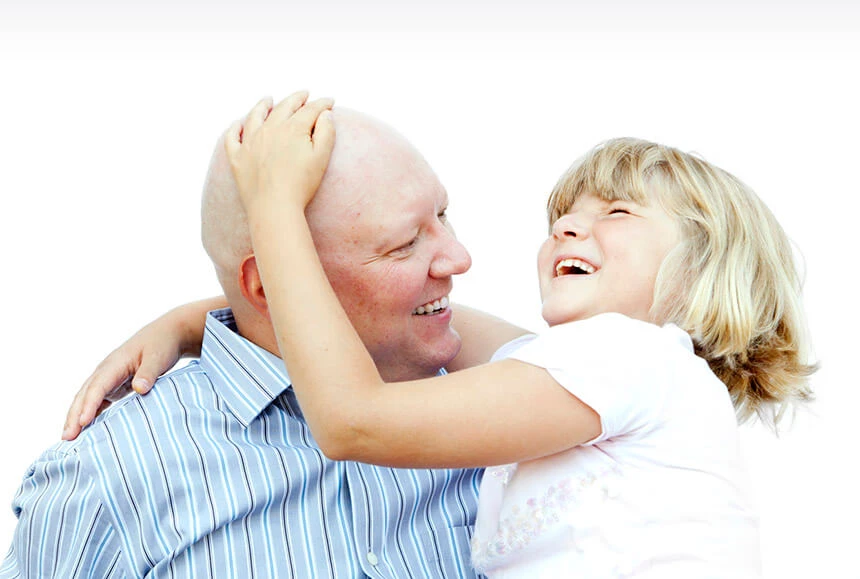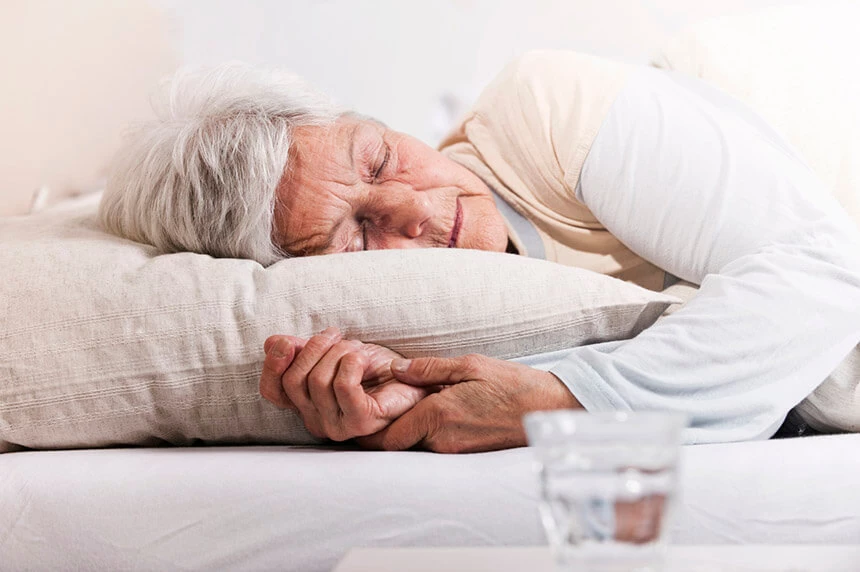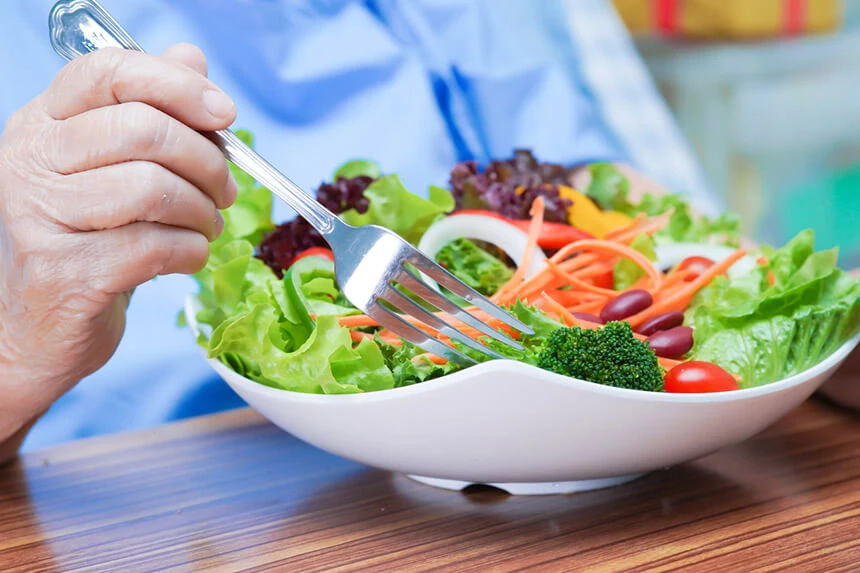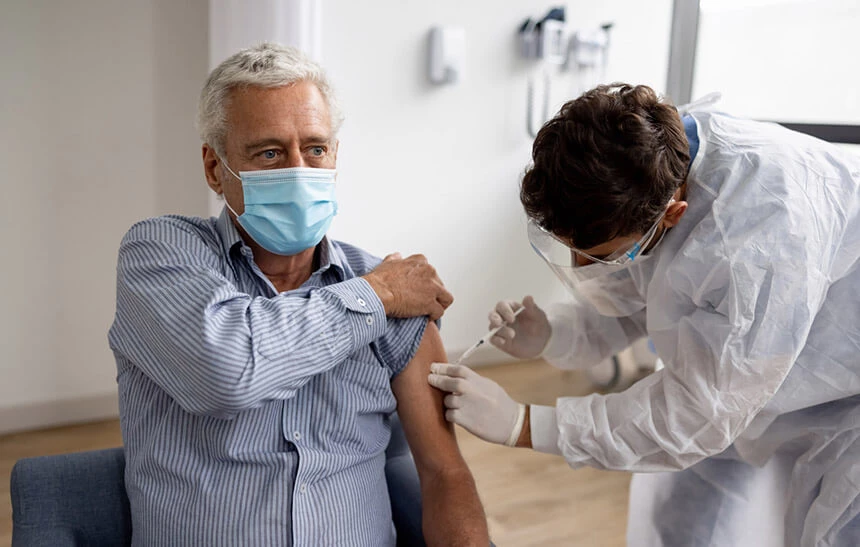Posttreatment is an extremely important part of patient care after completion of oncological treatment. Its proper course has a huge impact on faster recovery and improvement of the quality of life. Making a diagnosis and starting treatment is a diametrical change in a patient's life, which is why it is so important that he receives proper and comprehensive care after winning the fight against cancer. The key are: close cooperation with the attending physician, following his or her recommendations and unconditional adherence to them.

The patient should change his current habits and implement the six principles of lifestyle medicine. Belong to them:
- Healthy Eating,
- physical activity,
- healthy sleep,
- stress management,
- avoiding stimulants,
- social relations.
Compliance with them significantly affects both the results of the introduced treatment and the quality of life of the patient after cancer.
Detailed recommendations in each of the above areas should be developed with an appropriate specialist, under the supervision of the attending physician, because oncological diseases have different effects on the body.
Oncology as a field of medicine is developing very dynamically. The percentage of people for whom the treatment brought the expected effect is increasing. However, often used methods of treatment are aggressive and significantly interfere with the patient's body. This leads to many side effects that may last or appear even several months after the end of treatment.
The principles of lifestyle medicine listed above create instructions for the patient on how to lead a healthy lifestyle that will help the body fight the possible side effects of the treatment.
After the therapy, the patient should pay special attention to adapt his lifestyle to the recommendations issued by the doctor, not to strain or overload his body and psyche.
Recommendations for people who have completed oncological treatment often do not differ from those for any person who wants to improve their current health. These include primarily: physical exercise, a balanced diet, an appropriate BMI level, sleep hygiene, stress reduction and stopping the use of stimulants (completely giving up smoking and drinking alcohol).
In order to help the body return to fitness and improve the quality of life, you need to introduce a proper diet into your everyday life, which will allow the body to regenerate and help maintain well-being. It is necessary to consult a dietitian who will prepare a menu appropriate to the patient's health condition, select the appropriate consistency of the dish for the patient's health conditions and indicate a group of food products that should be abandoned.
Proper sleep hygiene has a positive effect on the regeneration of not only the body, but also the mind. It's important to plan at least 7 hours of sleep each night. It is worth introducing the so-called healthy sleep habits:
- establish a sleep schedule - regular,
- avoid looking at the phone and TV screen before falling asleep (up to 1-2 hours before bedtime),
- limit physical activity before bedtime (last exercise up to 2 hours before bedtime)
- keep the room where the patient falls asleep quiet, dim and cool.

Reducing stress for a patient who has won the fight against cancer can be very difficult. Nevertheless, it is worth the effort. Effective strategies for coping with stress can significantly improve the patient's quality of life. They help relieve anxiety and reduce anxiety with disease recurrence and re-treatment.
Effective stress management strategies include:
- using relaxation or meditation techniques, e.g. mindfulness training,
- support groups for people with cancer or after cancer treatment,
- interaction with friends and family, going to the cinema, theater or restaurant together.
Exercise and physical activity (even moderate), frequent and regular, can help reduce anxiety and depression, reduce nausea, pain, fatigue, and improve mood and self-esteem. If your doctor has told you to stay in bed during your recovery, you can start doing some light exercise, such as stretching or moving your legs or arms. It is worth consulting your physical activity with a specialist, e.g. a physiotherapist, who will show you exemplary exercises and correct any errors when performing them.
The most important thing for a patient after oncological treatment is to introduce a healthy lifestyle in small steps and not to get frustrated if at the beginning there is not enough strength for everything. Small
and slow change is always better than no change at all. It is fatigue that is one of the most frequently reported problems a year after the end of treatment. To effectively deal with fatigue, it is worth:
- plan your day,
- introduce breaks between daily activities (including naps),
- plan to sleep and wake up at the same times every day,
- be open to the help of others - sometimes it is worth accepting a helping hand, even with the smallest everyday activities.
Source:
Cancer survivors: Care for your body after treatment - Mayo Clinic
"Oncology Nursing. Handbook for medical studies” edited by Naukowa Anna Koper, Wydawnictwo Lekarskie PZWL, Warsaw 2011.
Patient after oncological treatment. Long-term complications of oncological treatment - Clinical practice - Medycyna Rodzinna - Practical Medicine for doctors (mp.pl)
Diet
A properly composed diet is important not only in cancer prevention or during the treatment itself, but also plays a huge role after its completion. The diet is to prevent the recurrence of the disease and cachexia and to maintain well-being.
What should a cancer survivor's diet look like? – main recommendations
- Excessive thinning as well as being overweight or obese are unfavorable to health. That is why it is so important to maintain a constant body weight. This is possible when the energy value of food is consistent with the body's energy expenditure.
- Meals should be as little processed as possible and consist of basic products.
- The diet should be varied and include products from all food groups:
- wholegrain cereal products
- vegetables
- fruit
- pods
- skim milk and fermented products
- curd cheeses
- vegetable fats
- fish
- eggs
- lean meat

In this way, the patient will be able to prevent nutrient deficiencies.
- It is worth following the principle of "less and more often" - it is recommended to eat 5-6 smaller meals during the day.
- When preparing meals, it is important to choose the cooking technique. The best are: steaming, cooking in water, stewing without adding fat, baking in aluminum foil or a heat-resistant dish.
- Energy comes from 3 main food sources: protein, fat and carbohydrates.
- The source of protein in the diet should be lean and semi-fat products. It is also worth including plant-based protein in your diet.
- Fat in the diet should be mainly vegetable or fish.
- Carbohydrates in the diet should be mainly complex, while sugar and sweets should be kept to a minimum.
- Each meal should contain vegetables, fruits and a dairy product. Half of your daily servings of vegetables and fruits should be raw. Vegetables are alkaline, contain a lot of antioxidant vitamins and minerals and fiber.
- Important vitamins and minerals in the diet are: vitamin C, A, E, D, beta carotene, calcium, selenium and magnesium.
- You need to take care of increased fiber intake, in particular its soluble fractions, to regulate the work of the digestive tract.
- The allowable amount of salt in the daily diet is 5 g (1 teaspoon). This standard applies to the entire amount of salt, both added to meals on its own, and that present in ready-made products. That is why it is so important to keep ready meals and processed products to a minimum.
- Optimally, a meal should be neither too cold nor too hot.
- After preparing a meal according to the recommended recommendations, it is important to eat slowly, chewing thoroughly.
- Drinking should not be forgotten in the daily diet. It is recommended to consume about 2 liters of fluids a day.
What is worth using in your daily diet? – recommended products
It's hard to compose balanced meals, with the right amount of all nutrients, without knowing. which products to choose from. Below are the categorized foods that are recommended for improving cancer survivor health.
- Wholegrain bread: graham, wholemeal, with the addition of grains and bran.
- Coarse groats: buckwheat, millet, barley, pearl barley; Brown rice; wholemeal flour pasta.
- Sprouts
- Skim milk and cottage cheese, fermented products: kefir, yoghurt, sour milk, buttermilk); tofu cheese.
- Eggs in the form of: soft-boiled, scrambled or steamed omelet
- Lean meat: skinless chicken/turkey, veal, pork loin.
- Fish, especially marine.
- Fat of vegetable origin: olive, rapeseed, linseed, soybean, sunflower, grape seed oil.
- Vegetables, especially green and orange: cabbage, cauliflower, spinach, eggplant, broccoli, Brussels sprouts, beetroot, pumpkin, squash, zucchini, watermelon, cucumber, carrot, tomato, kale, pepper, onion, garlic, horseradish, dill, parsley , leek, celery, chives.
- Fruits: blueberries, lemons, limes, oranges, grapefruits, apricots, peaches, apples, melons, grapes, strawberries, wild strawberries, figs.
- Legumes: beans, peas, broad beans, lentils, soybeans. Suggestion – long-term cooking of the legumes with the addition of aniseed, dill, fennel or cumin reduces the bloating properties of these plants and facilitates digestion.
Herbs and spices: basil, savory, cumin, coriander, lovage, marjoram, lemon balm, mint, cress, sage, chervil, cardamom, cinnamon, cloves, ginger, nutmeg, allspice, anise.

What is worth avoiding? – contraindicated products
Supporting the body after a hard period of cancer treatment also means avoiding what is not recommended for every healthy and sick person.
People with a history of cancer should especially avoid:
- fried and grilled dishes,
- fatty dairy products, e.g. cream, ripening cheese, blue cheese, processed cheese,
- meats, fish and smoked cheeses,
- pickled products with high salt content,
- canned meat and fish,
- fish in vinegar/brines,
- pork, goose, duck and dark beef - due to the high fat content,
- pates, sausages, luncheon meat, bacon, salami, brawn, black pudding or offal and fatty meats,
- fat contained in mayonnaise, lard, pork fat and hard margarines,
- ready-made confectionery and sweets, milk chocolate, creams and whipped cream,
- salty and fatty snacks such as: chips, crackers, salted peanuts, sticks,
- carbonated drinks,
- drinks with a high caffeine content,
- plenty of salt and pepper.
A dietician can help you create an appropriate menu and correct the current one. During the consultation, he will show the patient what he should pay attention to and what must not be missing from the diet, and will suggest sample meals. A comprehensive dietitian consultation can be arranged in Medicover - Dietician Privately | Medicover Medical Center

Sport and physical activity
Appropriate physical activity helps to reduce various unpleasant symptoms that may appear after oncological treatment: e.g. fatigue, anxiety and stress. It also reduces the risk of recurrence of the disease, as well as the occurrence of depressive episodes.
The type and intensity of physical activity must be individually adjusted to be safe and not to pose a risk of complications. Particular caution in undertaking physical activity is recommended for people after treatment of advanced cancer, especially when bone metastases have appeared, as well as for elderly people.
Often, it is not cancer or its treatment that hinders physical activity, but other diseases occurring in a given patient, e.g. anemia, respiratory diseases, heart failure, hypertension.
When taking up physical activity after an illness, even when you feel very well, you should always remember about the alarm symptoms, which include:
- severe neck or back pain,
- tingling and numbness of the fingers and toes,
- balance disorders,
- problems with maintaining urine and stool,
- progressive weakness of the lower limbs.
If any of these symptoms occur, stop activity immediately and see a doctor.
Guidelines for physical activity for children and adolescents after oncological treatment:
- at least 60 minutes of high to moderate intensity exercise a day, such as riding
on a scooter, rollerblades, running, games and activities;
- physical activity that strengthens the muscles three times a week, eg light weight exercise, swimming.
The effort should be adjusted to the condition and capabilities of the child, to his level of fitness and the course of the disease - so that he is safe. However, it should be remembered that any activity will be more beneficial than none. It is best to start with low-intensity exercises and gradually increase their frequency and duration.
Children and adolescents should limit the amount of time spent using electronic devices such as smartphones, tablets, computers - especially portable ones.
Guidelines for physical activity for adults aged 18-64 after completing oncological treatment:
- at least 150-300 minutes of moderate-intensity activity per week; it should be aerobic activities, such as: nordic walking, swimming, climbing stairs, exercises such as healthy spine, Pilates, elements of yoga, or at least 75-150 minutes of aerobic-intensive physical activity per week, such as: running, fast swimming, fast driving cycling, various types of sports training, such as climbing, martial arts, team games;
- muscle strengthening exercises twice a week: exercises with devices (resistance bands, dumbbells), in the gym in the club, in the outdoor gym;
- a combination of these activities is possible to obtain significant health benefits.
Adults can increase their moderate aerobic activity to over 300 minutes a week or over 150 minutes of intense exercise a week.
Physical activity guidelines for adults over 64 years of age after cancer treatment:
- older adults should do 150-300 minutes a week of moderate-intensity activity such as: gardening, cleaning, walking, water exercise, gentle exercise at home or at a health club, or 150 minutes of vigorous aerobic activity such as very brisk walking, running , fast swimming, cycling (for stationary safety), dancing;
- limit the amount of time you spend sitting;
- any activity is better than none: take the stairs instead of the elevator, walking instead of driving;
- exercise to strengthen all muscle groups twice a week - such activity provides additional health benefits;
- exercise at least three times a week to improve balance and prevent falls.

Check tests
After the oncological treatment is completed, it is the follow-up examinations that are an essential element of effective patient care. They are carried out to detect recurrence or secondary cancer at an early stage and to start treatment as soon as possible.
After the treatment is completed, the patient receives information about the date of follow-up examinations and further care. The examination plan is created individually for each patient, taking into account the needs and nature of the disease.
Patients who perform check-ups have a better chance of surviving and living in good health after the disease. The patient should remain under the observation of an oncologist for at least 2-3 years after the disease. At this time, the risk of its recurrence is the highest. The schedule of follow-up visits, along with detailed tests that the patient should perform, is determined individually with the attending physician, usually an oncologist, and depends primarily on the type and location of the cancer, treatment applied, clinical situation and general the patient's condition.
Control tests also allow to detect complications that may appear even after a few/dozens of months after the end of treatment and negatively affect the patient's well-being and reduce the quality of his life. Some of the complications require medical intervention, so it is very important to attend each of the check-ups appointed by your doctor.
During the visits, the patient can not only receive answers to bothering questions, but also consult a lifestyle or obtain recommendations and information on psychological, dietary or rehabilitation help. Therefore, he should accurately describe to the doctor all the disturbing symptoms and his current state of health, not only physical but also mental.
The tests carried out as part of the inspection include, among others:
- medical interview, during which the doctor asks about subjective feelings related to the patient's health,
- Laboratory tests,
- imaging tests,
- Ultrasound with lymph node biopsy,
- physical examinations (involving a thorough examination or auscultation of the patient
in a doctor's office).
It is recommended that the patient:
- before the follow-up visit, he wrote down the most important questions and disturbing symptoms that appeared.
- took a notebook/sheet of paper with a pen to the follow-up visit to write down the medical recommendations.
During the visit, the patient can always:
- ask the doctor about the side effects of the prescribed medications or possible ways of administering them,
- ask for brochures and information that will summarize what the doctor has given you,
- confirm the date of the next check-ups,
- let them know that they don't understand something and ask the doctor to repeat the information or explain it in more understandable language.
Source:
Post-treatment surveillance in most common solid malignancies in adults | jass | Cancers. Journal of Oncology (viamedica.pl)
Oncology after graduation - Observation after oncological treatment
Vaccinations
People treated for cancer and those who have completed treatment are more exposed than healthy people to viral and bacterial infections and to a more severe course of possible infection.
In a patient after the completion of oncological treatment, any infection can be a serious threat to life and health.
In immunocompromised people, even in the case of an incomplete response to vaccination, there is a significant benefit. Compared to unvaccinated people, the likelihood of severe complications (including death) during and after contracting a given disease is also lower. Very often, chemotherapy and radiotherapy are included in cancer treatment, which cause dysfunction of the immune system in patients, and this enables rapid infection. Therefore, supporting the immune system is very important. environment, in accordance with the cocoon strategy, which reduces the risk of transmission of infection from the environment. Vaccination of people from the patient's immediate environment may positively influence the prognosis and quality of life of the patient after the completion of oncological treatment.

The following vaccinations are recommended for these people:
- against influenza, annually with inactivated vaccines,
- live MMR (measles, mumps and rubella) vaccines, rotavirus and varicella vaccines.
Vaccinations recommended for people after oncological treatment are vaccinations against:
- diphtheria, tetanus, pertussis,
- flu,
- hib,
- invasive meningococcal infections,
- measles, mumps and rubella (MMR vaccine),
- chickenpox,
- pneumococci,
- hepatitis B,
- COVID-19.
Each time before making a decision about vaccination, the patient should discuss this fact with his doctor. Indications for vaccination of people with reduced immunity must be recognized individually and refer to a specific preparation. When making the decision to vaccinate, the doctor takes into account the patient's age and history of previous vaccinations and history of infections, exposure to infectious agents and medications that the patient is taking.
Vaccinations that are used in patients after cancer treatment should also depend on the history of the disease, its type of advancement, duration of immunosuppressive treatment or radiotherapy. After completion of cancer treatment, special emphasis should be placed on eligibility for vaccination. Patients with cancer and after treatment can be safely vaccinated with inactivated vaccines (e.g. diphtheria, tetanus, pertussis, pneumococcal, meningococcal, influenza, hepatitis B, hepatitis A, tick-borne encephalitis, HPV). Live vaccines (e.g. measles, rubella, and mumps MMR vaccines, and varicella vaccines) should not be given for 3-6 months after the end of anticancer treatment in patients with severe immunodeficiency, bone marrow transplants and organ transplants. blood or other blood products, should not receive live virus vaccine for 3 to 11 months.
In the case of children who have received chemotherapy, it is recommended that vaccinations be resumed within the immunization schedule after a minimum of three months from the end of chemotherapy.
In adult patients, vaccination with the 'live' preparation may take place 3 to 6 months after the completion of chemotherapy.
Despite the indicated exclusions, most immunocompromised patients tolerate vaccination well. They should not be afraid of adverse reactions other than vaccination in the general population.
In the case of vaccination of immunocompromised people, a special dosing schedule can be encountered (e.g. more doses are required than in healthy people) and partial reimbursement of the vaccine costs (e.g. in the case of influenza or pneumococcal vaccines).
All detailed information on the types of vaccines available in Poland is available on the website of the National Institute of Public Health - Szczeczenia.Info - Home page (pzh.gov.pl)
Information on the vaccination calendar, facts and myths, and vaccinations recommended for children and adults can be found on the Medicover website: Vaccinations | Why are vaccinations so important? (medicover.pl) and Vaccinations - facts and myths (medicover.pl)
It's also worth it
Source:
Vaccinations of cancer patients - page 2 - Interviews - Oncology - Practical Medicine for doctors (mp.pl)
Why do we vaccinate adults? - Vaccination.Info (pzh.gov.pl)
Can immunocompromised people be vaccinated? - Vaccination.Info (pzh.gov.pl)
Psychological support
Patients who struggle with cancer know very well that the support of another person is invaluable in their daily fight against it. The diagnosis itself brings a lot of emotions. The same is true for the information that long-term and often very aggressive treatment has been completed. The patient's fear is completely normal. That is why it is important to work through each emotion that arises with another person, preferably with a specialist (psychologist, psychotherapist, psycho-oncologist or psychiatrist).
Effective support should be tailored to the needs of the patient. It should be based on:
- reducing stress,
- exchange of emotions,
- a sense of security and hope.
Patients who experience the right support, more easily adapt to the doctor's recommendations, cope better with stress and anxiety, and are more willing to try to return to everyday life.
After treatment, it is very important to talk, discuss your feelings and emotions. Your conversation partner doesn't always have to be friends and family. It is worth seeking help from an outsider who will look at the patient's concerns from a slightly different angle.
The patient can benefit from the support of: a therapist, a therapeutic group of cancer survivors, and a therapeutic workshop group.
- The therapist helps to name and organize the emotions that patients struggle with. Together with the therapist, individual ways of dealing with unpleasant feelings can be developed. Therapeutic visits can take place cyclically, according to the schedule agreed with the therapist, both online and stationary.
- Therapeutic groups of cancer survivors are an ideal environment for patients to share their feelings, experiences and thoughts. While participating in support group meetings, the patient can share his feelings with people who have gone through the same path, get inspiration
from the stories of other group members, but also be a motivation for others. Therapeutic groups operate stationary and online. In addition to the opportunity to talk, frequent participation in such a group brings many other benefits, such as joint picnics, going to the cinema or going for a walk.
- Workshop therapeutic groups – these are meetings in the form of workshops, during which patients learn relaxation techniques, stress management, greater awareness of their body and mind. Most often, such groups focus on mindfulness training, the so-called mindfulness and music therapy.
Individual meetings with a therapist can complement group therapy, and vice versa. If the patient feels that one form of help is not enough for him, he can use other types of help at the same time. Sometimes the therapist himself, during meetings with the patient, proposes other forms of help and invites the patient to therapeutic groups or workshops.
A list of organizations that provide psychological support, but also serve to exchange information between patients, is available at:
Patient organizations / Use the help of patient organizations / For the Patient / National Health Fund (NFZ) – we finance the health of Poles
Source:
"Oncology Nursing. Handbook for medical studies” edited by Naukowa Anna Koper, Wydawnictwo Lekarskie PZWL, Warsaw 2011.
https://www.mayoclinic.org/diseases-conditions/cancer/in-depth/cancer-survivor/art-20047129
https://www.mdpi.com/1718-7729/29/5/261/html
Palliative care
Unfortunately, sometimes it happens that oncological treatment ends and palliative (hospice) care has to be implemented. It is associated with the most difficult tasks that a cancer patient faces. Palliative care is based on understanding the deepest, often unspoken needs of suffering or terminally ill patients. It's not only about it
for relief of physical pain, but also for spiritual support. Palliative care patients should feel, above all, that they are still a part of society. Thanks to this, the process of leaving can become the most valuable for them. The aim of palliative care activities is primarily to improve the quality of life of the patient and his relatives.
Palliative care includes:
- alleviating mental suffering,
- prevention of pain and other somatic symptoms,
- spiritual help,
- social assistance,
- supporting the family during the illness and after the patient's death.
Due to the multidimensional nature of palliative care, it should be provided by a team of specialists, including a doctor and a nurse, as well as (depending on the needs): a psychologist, a priest, a physiotherapist, a dietician, a social worker, and a volunteer. This team, in addition to empathy, should have the ability to communicate and be well organized and responsible. It should help to accept the inevitability of death, show both the patient and people from his immediate environment that grief and suffering are deeply human and natural feelings. The entire team should work with the patient and family to define goals and priorities for care, discuss available treatment options, and jointly formulate a plan of care that respects the patient's wish to refuse treatment and the right to relief of suffering and pain.
Any palliative care patient can nominate another person to enforce their rights when they are unable to make decisions. The declaration in which he designates such a person may be withdrawn or amended at any time.
There are several forms of palliative care:
- stationary care - consists in helping the patient in stationary conditions - in hospices or palliative care wards;
- home care – consists in providing assistance to the patient by the home care team at the patient's home;
- outpatient care - help is provided at the palliative medicine clinic, use it
people who are able to report directly to the clinic for pre-arranged visits can use it.
The type of palliative care should be selected primarily on the basis of the patient's condition and after consultation with his relatives.
Not every treatment has to end with the need to implement palliative care.
Detailed information along with a search engine for palliative care facilities is available on the website of the Ministry of Health:
Palliative and hospice care | Patient
Source:
"Oncology Nursing. Handbook for medical studies” edited by Naukowa Anna Koper, Wydawnictwo Lekarskie PZWL, Warsaw 2011.
Summary:
and attending follow-up examinations as directed. The patient should be monitored by an oncologist for at least 2-3 years after the disease;
|


